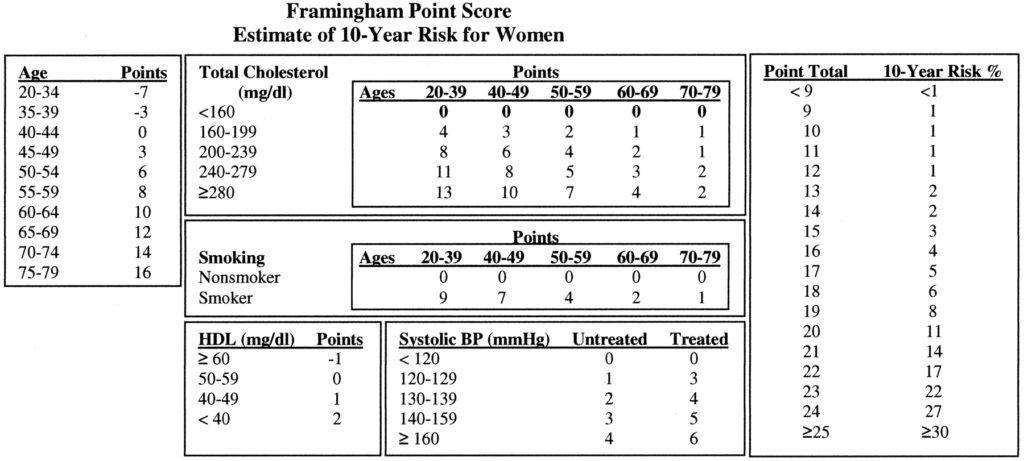Contents:
- Medical Video: Heart Attack Warning Signs
- Calculate the risk of a heart attack through the Framingham Risk Score (FRS)
- High risk (> 1 high risk condition)
- Medium risk or risk (> 1 major risk factor)
- What are the criteria for optimal heart condition?
Medical Video: Heart Attack Warning Signs
Heart disease has become a disease that is familiar to us. This disease is the number 3 cause of death in the world. In fact, we can predict the emergence of an attack with signs that exist, so that we can actively prevent it before it occurs. In women, symptoms that arise usually are not typical. Therefore, we must calculate the potential for attacks from afar.
Various studies have been carried out in the prediction of heart attack risk, the most famous of which is Framingham Heart Study (FHS). From the FHS, a prediction model was developed called as Framingham Risk Score (FRS), to predict the occurrence of cardiovascular events in the next 10 years. Predictions between men and women are slightly different, this difference arises because of the age difference in attacks from previous cases, as well as the interaction of risk factors that affect a person.
Calculate the risk of a heart attack through the Framingham Risk Score (FRS)
The Framingham Risk Score (FRS) consists of several components which include age, total blood cholesterol, smoking habits, total HDL (good cholesterol), and systolic blood pressure. So before calculating, you should check the fat profile first. This check should be routinely carried out to find out the fat profile in the body which is strongly influenced by a very dynamic diet. From the sum of the various components, it will be known how risky you are for a heart attack. Let's count our scores through the table below
Besides FHS, there are several prediction models with other scoring systems. Various studies are developed and are expected to be able to perfect and predict more precisely, among others Reynolds Risk Score (RRS) and Systematic Coronary Risk Evaluation (SCORE). FRS and RRS are more widely used in groups in the United States, while SCORE is developed exclusively from study data in European countries. In Indonesia, 3 models of this calculation can still be applied, the easiest is FRS. After calculating through the table above, we must pay attention to the things below, before doing prevention. Following is the Guide American Heart Association in 2011 which included other risk factors and tried to estimate the long-term risk beyond the conventional 10-year prediction.
High risk (> 1 high risk condition)
- Heart disease that has manifested clinically, for example, the heart often palpitates, fatigue during activity, and chest pain
- Cerebrovascular disease that has manifested clinically, for example, has had a stroke
- Peripheral arterial disease that has clinical manifestations
- Chronic kidney disease
- Diabetes mellitus
- Cardiovascular risk predictions> 10% within 10 years
Medium risk or risk (> 1 major risk factor)
- Smoke
- Blood pressure (BP) systolic> 120 mmHg and Diastolic BP> 80 mmHg or hypertension in therapy
- Total cholesterol> 200 mg / dl, HDL-C <50 mg / dL or get dyslipidemia therapy
- Obesity, especially central obesity (distended stomach)
- Unhealthy eating patterns
- Physical inactivity
- Family history of early heart attack (men aged <55 years or women <65) in one generation before, for example father, mother, uncle or aunt
- The presence of metabolic syndrome is characterized by large abdominal circumference and poor fat profile
- Ability to exercise capacity as evidenced by the treadmill weight training test or abnormal pulse recovery after stopping the training test
- Vascular collagen disease due to autoimmune disorders (lupus or rheumatois arthritis)
- History of preeclampsia (pregnancy poisoning), gestational diabetes (in pregnancy), or pregnancy-related hypertension
What are the criteria for optimal heart condition?
The optimal heart condition is the ideal condition that prevents a person from a heart attack. All criteria must be met before the heart is declared to be in optimal condition. Keriteria, among others:
- Total cholesterol <200 mg / dL (without drug therapy)
- TD <120/80 mmHg (without drug therapy)
- Fasting blood sugar <100 mg / dL (without drug therapy)
- Body mass index <25 kg / m2
- Do not smoke
- Physical activity for adults> 20 years: moderate intensity exercise> 150 minutes per week, exercise intensity> 75 minutes / week
- Follow a healthy diet (DASH diet or its variants)
Well, after following the explanation above, even though you currently look fine, there are no complaints, it's a good idea to start calculating potential that might be experienced later on. That way, you can actively prevent by changing your life habits, diet, activity patterns, and other lifestyle to be healthier. Good luck.
READ ALSO:
- 6 Symptoms of a Heart Attack in Women
- 9 Tips to Reduce the Risk of Heart Attack or Stroke
- Frequent Tiredness, One of the Symptoms of Heart Valve Disease













